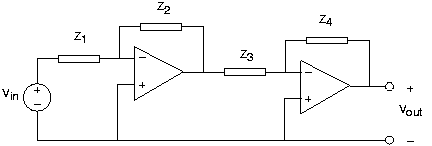| << Chapter < Page | Chapter >> Page > |
You are given the depicted circuit .

Because the differential equations arising in circuits resemble those that describemechanical motion, we can use circuit models to describe mechanical systems. An ELEC 241 student wants tounderstand the suspension system on his car. Without a suspension, the car's body moves in concert with the bumpsin the raod. A well-designed suspension system will smooth out bumpy roads, reducing the car's vertical motion. Ifthe bumps are very gradual (think of a hill as a large but very gradual bump), the car's vertical motion shouldfollow that of the road. The student wants to find a simple circuit that will model the car's motion. He istrying to decide between two circuit models ( [link] ).

Here, road and car displacements are represented by the voltages and , respectively.
You are given the depicted network .

You are given an unopenable box that has two terminals sticking out. You assume the box contains a circuit. Youmeasure the voltage across the terminals when nothing is connected to them and the current when you place a wire across the terminals.
Find the voltage in each of the depicted circuits .


Find the transfer function between the source voltage(s) andthe indicated output voltage for the circuits shown in [link] .




The following circuit is claimed to serve a useful purpose.

The circuit of a cascade of op-amp circuits illustrate the reason whyop-amp realizations of transfer functions are so useful.


Consider the depicted circuit .

We want to design a bandpass filter that has transferthe function Here, is the cutoff frequency of the low-frequency edge of the passband and is the cutoff frequency of the high-frequency edge. We want and .
In audio applications, prior to analog-to-digital conversion signals are passed throughwhat is known as a pre-emphasis circuit that leaves the low frequencies alone but provides increasinggain at increasingly higher frequencies beyond some frequency . De-emphasis circuits do the opposite and are applied after digital-to-analog conversion. Afterpre-emphasis, digitization, conversion back to analog and de-emphasis, the signal's spectrumshould be what it was.
The op-amp circuit here has been designed for pre-emphasis or de-emphasis (Samantha can'trecall which).

Find the transfer function of the depicted active filter .

You are given a circuit .

In your optical telephone, the receiver circuit had the form shown .

This circuit served as a transducer, converting light energy into a voltage . The photodiode acts as a current source, producing a current proportional to the light intesityfalling upon it. As is often the case in this crucial stage, the signals are small and noise can be aproblem. Thus, the op-amp stage serves to boost the signal and to filter out-of-band noise.

The depicted circuit has been developed by the TBBG Electronics design group. They are trying to keep itsuse secret; we, representing RU Electronics, have discovered the schematic and want to figure out theintended application. Assume the diode is ideal.


Notification Switch
Would you like to follow the 'Fundamentals of electrical engineering i' conversation and receive update notifications?